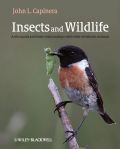
The purpose of this book is to provide a comprehensive overview of the interrelationships of insects and wildlife. Surprisingly, this has not been attempted previously. Secondarily, this book is prepared in the form of a textbook, providing an introduction of insects to wildlife biologists and other vertebratebiologists, and emphasizing the importance of insects to wild vertebrate animals. If used for teaching introductory entomology, this book provides the first new approach to teaching insect biology that has been developed in several decades. Anyone who has taught introductory entomology will find some familiar elements in this book; however, there are some entirely unique aspects and thecontext is completely novel. Consistent with the textbook concept, I have provided a summary at the end of each chapter, highlighted and defined the important entomological and ecological terminology, and provided a glossary of terms. 1. Contents (See also, Table of Contents) Chapter 1. Insects and their relatives. This initial chapter is an overview of insects, and serves as a foundation for understanding what constitutes an insect. For anyone having had an entomology course, this chapter is review material. However, for those lacking prior exposure to this discipline, this chapter is essential reading. This first chapter explains the relationship of insects to similar invertebrates, emphasizing closely related organisms such as spiders, ticks, and centipedes. Evolution and classification of insects are also presented, but the major emphasis ison insect form and function. All the major life systems are briedly described, complete with illustrations. Insects can be quite different than vertebrates, and this section treats their differences and similarities before closing with discussion of insect feeding ecology. Chapter 2. Insects as a food resourcefor wildlife. This is a large and chapter that, for the first time, brings focus to the role of insects as food for vertebrate animals. All the major groups of vertebrates are discussed. Data gleaned from numerous dietary studies arepresented in tabular form so the reader can see the differences in feeding behavior, and the importance of insects in the diet. Information on measuring the diet of wildlife, the nutritional value of insects to vertebrate animals, and the importance of insects to wildlife fitness also are presented. The diverse means by which insects avoid being consumed by wildlife are reviewed. Finally, the taxa (orders and families) that are important food items for wildlife are discussed briefly. Chapter 3. Other important roles of insects in ecosystems. Whereas Chapter 2 discussed the direct influence of insects as an element of wildlife habitat by comprising their food, Chapter 3 discusses the more indirect effects, the role of insects in ecosystem processes such as decomposition, nutrient cycling, pollination and herbivory. These critical ecosystem processes affect not only the availability of food, but the availability of shelter and other necessary environmental requisites. This section closes with a detailed discussion of invasiveness by insects, a timely and important topic because many natural ecosystems and the wildlife sheltered therein are affected by invading insects. Chapter 4. Transmission of diseases to wildlife by arthropods. This chapter is an introduction to parasitology and epidemiology, and is thefirst of four chapters devoted to the subject. These disciplines have unique terminologies that warrant separate introduction before discussing the role ofinsects in disease transmission, as it would be a mistake to assume prior knowledge of these specialties. I also present general information on the importance of disease and parasitism in wildlife. Chapter 5. Infectious diseases transmitted to wildlife by arthropods. The infectious diseases transmitted by insects are caused by viruses, bacteria, protozoa, and fungi. The characteristics of each type of microbial organism are presented, as well as examples of diseases transmitted by insects that involve wildlife. I present examples of diseases that are debilitating or lethal to wildlife, but also some that do not significantly affect wildlife but are transmitted by insects from wildlife to humans. Chapter 6. Parasitic diseases transmitted to wildlife by arthropods. The parasitic diseases transmitted by insects are caused by protozoa and helminths.As in Chapter 5, the characteristics of each type of microbial organism are presented, as well as examples of diseases transmitted by insects that involve wildlife. Likewise, I present examples of diseases that are debilitating or lethal to wildlife, but also some that do not significantly affect wildlife but are transmitted by insects from wildlife to humans. Chapter 7. Arthropods as parasites of wildlife. This chapter discusses insects and related arthropods that affect wildlife. The characteristics of the principal groups and the types of injury they inflict on wildlife are presented. Also included are some specific examples of arthropods that are particularly important as pests of wildlife or that affect humans but use wildlife as a host. Chapter 8. Pest managementand its effects on wildlife. Here I discuss the types of pesticides that are used, and how they affect wildlife. Also, an overview of alternatives to pesticides is presented, including alternative technologies and approaches such as host plant resistance, biological control, physical control, and integrated pest management. Chapter 9. Conservation issues. Like Chapter 2, this chapter presents some unusual information. The importance of wildlife in the regulation of insect populations is documented, as are the non-disease aspects of wildlife population regulation by insects. The many benefits of insects are also outlined, including wildlife habitat preservation resulting from transmission of diseases to humans by insects. I also present the idea that insects are small wildlife, and worthy of conservation, plus some examples of insect conservationproblems. Finally, I provide information on how insect populations can be manipulated to benefit wildlife.Head of Department of Entomology, University of Florida, USA
- ISBN: 978-1-4443-3299-5
- Editorial: Wiley-Blackwell
- Encuadernacion: Cartoné
- Páginas: 500
- Fecha Publicación: 12/03/2010
- Nº Volúmenes: 1
- Idioma: Inglés
